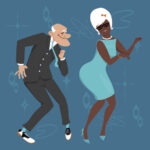You’re a Deadhead, a casual listener, or maybe just someone wandering through a festival – chances are you’ve encountered the iconic Grateful Dead Dancing Bears. These whimsical, colorful bears are more than just a cool design; they’re a symbol deeply embedded in the band’s history and counter-culture spirit. But where did these bears come from? Let’s delve into the psychedelic origins of this beloved motif.
 Grateful Dead dancing bears design on a banner
Grateful Dead dancing bears design on a banner
The Artistic Birth of the Dancing Bears: Bob Thomas and Owsley Stanley
The story of the Grateful Dead dancing bears begins with artist Bob Thomas, a key figure in the band’s visual identity. Thomas wasn’t just any artist; he was a “renaissance man” within the Grateful Dead community. His creation of the dancing bears was specifically for the back cover of the 1973 album History of the Grateful Dead, Volume 1 (Bear’s Choice). However, Thomas’s contributions to the Grateful Dead’s visual language went far beyond these bears. He was also the co-designer, alongside Owsley Stanley, of the band’s instantly recognizable “Lightning Bolt” logo in 1969. This logo was initially practical – a way to identify the band’s equipment while touring – but quickly became another enduring symbol. Thomas’s artistic touch extended to other Grateful Dead albums, including Steal Your Face and Live Dead, and even to the logo for Alembic, the high-end instrument company founded by the Grateful Dead’s sound engineer, Owsley Stanley.
“Bear’s” Inspiration: Owsley Stanley and a Typographic Find
So, why bears? The answer lies in Owsley Stanley, affectionately nicknamed “Bear.” This moniker wasn’t random; childhood friends bestowed it upon him due to his notably hairy chest. Adding to the lore, some speculate the “Dancing Bear” aspect arose from Stanley’s unique, perhaps acid-fueled, dance moves witnessed at Grateful Dead concerts. However, the visual style of the bears we know and love wasn’t inspired by Stanley’s dance moves directly. Instead, Bob Thomas stumbled upon a 36-point lead type slug featuring a generic bear print. This simple, blocky bear design became the primary artistic springboard for the Grateful Dead dancing bears we recognize today.
From Album Art to Blotter Art: Popularizing the Bears
The Bear’s Choice album release in 1973 marked the dancing bears’ public debut, introducing them to a wider audience. Yet, album sales alone don’t fully explain their explosive popularity. Owsley Stanley’s other significant role played a crucial part: he was a pioneer in private LSD manufacturing. This connection is key to understanding the bears’ cultural explosion. After the album’s release, the dancing bear motif began appearing on Stanley’s LSD blotter art. These blotter sheets, featuring the now-iconic bears, were widely circulated, particularly within the vibrant social scene surrounding Grateful Dead concerts. The convergence of the bears on album art and within the communal experience of drug use at Dead shows solidified their symbolic power. They became instantly recognizable emblems deeply intertwined with the Grateful Dead experience. From there, the Deadhead community embraced the bears wholeheartedly. Fans began creating their own merchandise – bootleg stickers, t-shirts, and more – amplifying the symbol’s reach and cementing the dancing bears as an everlasting emblem of the Grateful Dead and their unique cultural phenomenon.
Ready to show off your Deadhead spirit?


